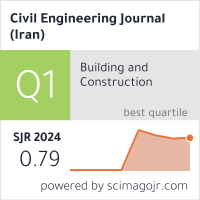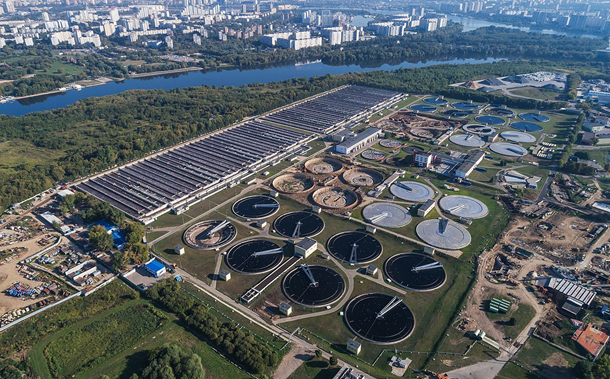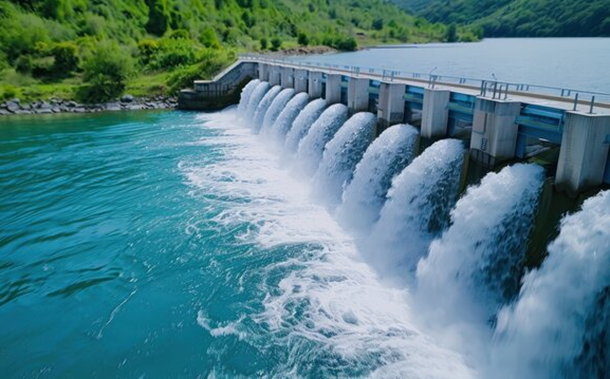Strength Properties of Polymer Reactive Powder Concrete with Waste Materials
Downloads
Doi:10.28991/CEJ-2023-09-08-09
Full Text:PDF
Downloads
[2] Rashed, L. (1998). Behavior of Fiber Reinforced Concrete Exposed to Oil Products. Master Thesis, University of Technology, Baghdad, Iraq.
[3] Mayhoub, O. A., Nasr, E. S. A. R., Ali, Y. A., & Kohail, M. (2021). The influence of ingredients on the properties of reactive powder concrete: A review. Ain Shams Engineering Journal, 12(1), 145–158. doi:10.1016/j.asej.2020.07.016.
[4] Richard, P., & Cheyrezy, M. (1995). Composition of reactive powder concretes. Cement and Concrete Research, 25(7), 1501–1511. doi:10.1016/0008-8846(95)00144-2.
[5] Richard, P., & Cheyrezy, M. H. (1994). Reactive Powder Concretes with High Ductility and 200 - 800 MPa Compressive Strength. SP-144: Concrete Technology: Past, Present, and Future. doi:10.14359/4536.
[6] Hasan, S., & Nayyef, D. (2020). Investigation of using waste glass powder as a supplementary cementitious material in reactive powder concrete. Proceedings of International Structural Engineering and Construction, ISEC Press, 7(1), 1-6. doi:10.14455/ISEC.res.2020.7(1).SUS-07.
[7] Sanjuán, M. í., & Andrade, C. (2021). Reactive powder concrete: Durability and applications. Applied Sciences (Switzerland), 11(12), 5629. doi:10.3390/app11125629.
[8] Thari, A. I., Salih, S. A., & Hasan, S. S. (2020). Influence of using different percentages of waste materials on the strength properties of polymer concrete. IOP Conference Series: Materials Science and Engineering, 737(1), 012067. doi:10.1088/1757-899x/737/1/012067.
[9] Ohama, Y. (1987). Principle of latex modification and some typical properties of latex-modified mortars and concretes adhesion; binders (materials); bond (paste to aggregate); carbonation; chlorides; curing; diffusion. Materials Journal, 84(6), 511-518. doi:10.14359/2463.
[10] ACI 548.1R-86. (1986). Guide for the Use of Polymers in Concrete. American Concrete Institute (ACI), Michigan, United States.
[11] BărbuŠ£Äƒ, M., Harja, M., & Baran, I. (2010). Comparison of Mechanical Properties for Polymer Concrete with Different Types of Filler. Journal of Materials in Civil Engineering, 22(7), 696–701. doi:10.1061/(asce)mt.1943-5533.0000069.
[12] Zhao, C., Yi, Z., Wu, W., Zhu, Z., Peng, Y., & Liu, J. (2021). Experimental study on the mechanical properties and durability of high-content hybrid fiber–polymer concrete. Materials, 14(21). doi:10.3390/ma14216234.
[13] Al-Numan, S. B., & Ismail Al-Hadithi, A. (2008). Behavior of Polymer Modified Concrete Slabs under Impact. Iraqi Journal of Civil Engineering, 5(11), 1–24. doi:10.37650/ijce.2008.45139.
[14] Shirshova, N., Menner, A., Funkhouser, G. P., & Bismarck, A. (2011). Polymerised high internal phase emulsion cement hybrids: Macroporous polymer scaffolds for setting cements. Cement and Concrete Research, 41(4), 443–450. doi:10.1016/j.cemconres.2011.01.017.
[15] Martinez-Barrera, G., Vigueras-Santiago, E., Gencel, O., & Hagg Lobland, H. E. (2011). Polymer concretes: a description and methods for modification and improvement. Journal of Materials Education, 33(1), 37.
[16] St Cholakov, G. (2009). Control of Pollution in the Petroleum Industry. Pollution Control Technologies-Vol. III-Control of Pollution in the Petroleum Industry. Available online: http://www.eolss.net/sample-chapters/c09/e4-14-04-03.pdf (accessed on May 2023).
[17] Al-Sabaeei, A. M., Al-Fakih, A., Noura, S., Yaghoubi, E., Alaloul, W., Al-Mansob, R. A., ... & Yaro, N. S. A. (2022). Utilization of palm oil and its by-products in bio-asphalt and bio-concrete mixtures: A review. Construction and Building Materials, 337, 127552. doi:10.1016/j.conbuildmat.2022.127552.
[18] Tabsh, S. W., & Alhoubi, Y. (2022). Experimental Investigation of Recycled Fine Aggregate from Demolition Waste in Concrete. Sustainability (Switzerland), 14(17), 10787. doi:10.3390/su141710787.
[19] Yehia, S., Helal, K., Abusharkh, A., Zaher, A., & Istaitiyeh, H. (2015). Strength and Durability Evaluation of Recycled Aggregate Concrete. International Journal of Concrete Structures and Materials, 9(2), 219–239. doi:10.1007/s40069-015-0100-0.
[20] Elchalakani, M., & Elgaali, E. (2012). Sustainable concrete made of construction and demolition wastes using recycled wastewater in the UAE. Journal of Advanced Concrete Technology, 10(3), 110–125. doi:10.3151/jact.10.110.
[21] Verian, K. P., Ashraf, W., & Cao, Y. (2018). Properties of recycled concrete aggregate and their influence in new concrete production. Resources, Conservation and Recycling, 133, 30–49. doi:10.1016/j.resconrec.2018.02.005.
[22] Mohammed Ali, A. A., Zidan, R. S., & Ahmed, T. W. (2020). Evaluation of high-strength concrete made with recycled aggregate under effect of well water. Case Studies in Construction Materials, 12, e00338. doi:10.1016/j.cscm.2020.e00338.
[23] Jin, R., Li, B., Elamin, A., Wang, S., Tsioulou, O., & Wanatowski, D. (2018). Experimental Investigation of Properties of Concrete Containing Recycled Construction Wastes. International Journal of Civil Engineering, 16(11), 1621–1633. doi:10.1007/s40999-018-0301-4.
[24] Onyelowe, K. C., Gnananandarao, T., Ebid, A. M., Mahdi, H. A., Ghadikolaee, M. R., & Al-Ajamee, M. (2022). Evaluating the Compressive Strength of Recycled Aggregate Concrete Using Novel Artificial Neural Network. Civil Engineering Journal, 8(8), 1679–1693. doi:10.28991/cej-2022-08-08-011.
[25] Dabiri, H., Kioumarsi, M., Kheyroddin, A., Kandiri, A., & Sartipi, F. (2022). Compressive strength of concrete with recycled aggregate; a machine learning-based evaluation. Cleaner Materials, 3. doi:10.1016/j.clema.2022.100044.
[26] Naouaoui, K., & Cherradi, T. (2021). A case study on the mechanical and durability properties of a concrete using recycled aggregates. Civil Engineering Journal, 7(11), 1909–1917. doi:10.28991/cej-2021-03091768.
[27] Mi, R., Pan, G., Liew, K. M., & Kuang, T. (2020). Utilizing recycled aggregate concrete in sustainable construction for a required compressive strength ratio. Journal of Cleaner Production, 276. doi:10.1016/j.jclepro.2020.124249.
[28] Naderpour, H., & Mirrashid, M. (2020). Estimating the compressive strength of eco-friendly concrete incorporating recycled coarse aggregate using neuro-fuzzy approach. Journal of Cleaner Production, 265. doi:10.1016/j.jclepro.2020.121886.
[29] Al-Attar, T. S., Ali, A. S., & Al-Numan, B. S. (2019). The effect of coarse aggregate inclusion on the performance of reactive powder concrete exposed to oil products. IOP Conference Series: Materials Science and Engineering, 579(1), 012044. doi:10.1088/1757-899x/579/1/012044.
[30] Iraqi Specification No.5/1984. (1984). Portland Cement. Iraqi Specification, Baghdad, Iraq.
[31] Iraqi Specifications No.45/1984. (1984). Aggregates of Natural Resources used for Concrete and Construction. Iraqi Specification, Baghdad, Iraq.
[32] Ali, A. S. (2006). Mechanical properties and durability of original and polymer modified reactive powder concrete exposed to oil products. Ph.D. Thesis, University of Technology, Baghdad, Iraq.
[33] Ohama, Y. (1997). Recent progress in concrete-polymer composites. Advanced Cement Based Materials, 5(2), 31–40. doi:10.1016/s1065-7355(96)00005-3.
[34] Al-Wahili, A.A. (2005). Mechanical properties of steel fiber reinforced reactive powder concrete. Master Thesis, University of Technology, Baghdad, Iraq.
[35] BS-1881 Part 116. (1983). Testing concrete-Part 116: Method for determination of compressive strength of concrete cubes. British Standard Institution, London, United Kingdom.
[36] Neville, A.M. (2011) Properties of Concrete (5th Ed.). Longman, Harlow, United Kingdom.
[37] Al-Attar, T. S., Ali, A. S., & Al-Nu'man, B. S. (2012). Behavior of polymer modified reactive powder concrete exposed to oil products. Brittle Matrix Composites 10. Woodhead Publishing, Sawston, United Kingdom.
[38] Nasaif, W., & Hasan, S. (2022). Properties of Green Reactive Powder Concrete Containing Different Recycled Materials. Proceedings of International Structural Engineering and Construction, 9(2). doi:10.14455/ISEC.2022.9(2).MAT-19.
[39] Hasan, S. (2019). Some properties of reactive powder concrete made with recycled aggregate. Proceedings of International Structural Engineering and Construction, 6(1), 1-6. doi:10.14455/isec.res.2019.156.
[40] ASTM C496-96. (2017). Standard Test Method for splitting Tensile Strength of Cylindrical Concrete Specimens. ASTM International, Pennsylvania, United States. doi:10.1520/C0496-96.
[41] ASTM C293/C293M-16. (2016). Standard Test Method for Flexural Strength of Concrete (Using Simple Beam with Center-Point Loading). ASTM International, Pennsylvania, United States. doi:10.1520/C0293_C0293M-16.
- Authors retain all copyrights. It is noticeable that authors will not be forced to sign any copyright transfer agreements.
- This work (including HTML and PDF Files) is licensed under a Creative Commons Attribution 4.0 International License.![]()















